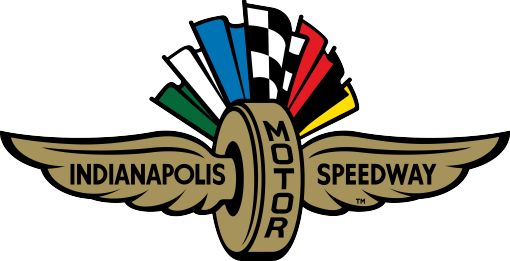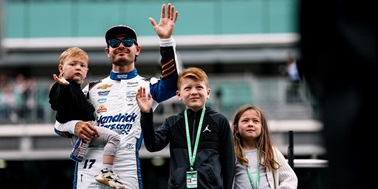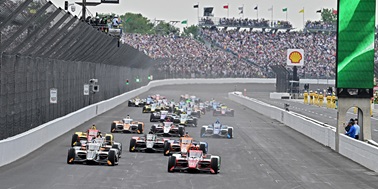Sometimes a driver’s true measure of courage and character isn’t measured by the way they handle victory but the amount of class and dignity in which they handle defeat.
That is certainly the measure of JR Hildebrand’s courage, character, class and dignity with how he dealt with the enormous turn of events that turned him from a sure winner of the 100th Anniversary Indianapolis 500 to a crushing defeat in the blink of an eye and a crash into the fourth turn wall.
All Hildebrand had to do to achieve Indianapolis 500 immortality was make it through the final turn of the final lap, and he could cruise to the checkered flag. But as he came racing through the north chute between Turns 3 and 4, he approached fellow rookie Charlie Kimball’s car after it ran out of fuel. Rather than let off the accelerator, Hildebrand made the fateful decision to keep his foot on the throttle. He drifted high on the racetrack but got into the “marbles” – the area of the track surface where pellets of used rubber off the tires had drifted up the track, making it slippery, like running on marbles.
He lost control of his National Guard/Panther Racing Dallara and slammed into the SAFER Barrier in Turn 4. Hildebrand skidded down the frontstraight and appeared that he could slide the crashed car across the finish line, but Dan Wheldon charged from the back to make the pass for the victory.
Hildebrand had suddenly become the modern day “Bill Buckner” – the first baseman for the Boston Red Sox who booted Mookie Wilson’s ground ball through his legs in the fateful Game 6 of the 1986 World Series, allowing Ray Knight to score the winning run for the New York Mets. The Mets would go on to win Game 7 and the Series that year, and Buckner continues to live in infamy.
“Bill Buckner got hit that ground ball a million times in practice, and he just blew it because he was under pressure,” Hildebrand said. “I play baseball, so I feel for Bill Buckner every time I see that.
“To me it was on ESPN ‘First Take’ that Skip Bayless called what I did the biggest choke of all-time. I said, ‘Shoot, put me on that show, and I’ll debate him all day long.’ Did he watch any of the race? The Indy 500 is the one race where people who don’t watch racing see what happens, so to be honest with you, when it all came down having played sports in baseball and when you are the closer and you blow it, then you blew it. That is how it works in sports. It’s not something I don’t think about, but it isn’t something that keeps me awake at night. When I look back at what happened, I could have made a better decision. But knowing how quickly I had to make a decision, I don’t have any regret making the decision that I did.
“It’s not something that really bugs me.”
Growing up in the San Francisco Bay area, Hildebrand admits his first love was baseball. He was quite a prospect in high school. Ever the baseball fan, Hildebrand understands how he has become IndyCar’s version of “Bill Buckner” when it comes to infamy.
But Hildebrand, 23, will not let what happened in last year’s Indianapolis 500 define him as a person.
Rather than sulk, Hildebrand handled the disappointment like a man.
“I showed to some degree last year after the race it doesn’t bother me to talk about this stuff,” Hildebrand said. “I’m not going to shy away from it. For me, personally, in my first time at going through the Indianapolis 500, we sort of showed that we could just about beat anybody. We are going to roll that into this season and be more aggressive.
“You end up getting asked about it. The question every time is the same, `So, tell us what happened in the last corner of the Indy 500.’ At this point, I have a standard answer I give to everybody about it. You expect that, so it is no big deal now. It’s like I said when it all went down: It sucks that is what ended up happening when we had a shot at winning the race, but from an optimistic point of view, it gave us the confidence that this is our first time doing this, and we were damn close. It does give us confidence we can be there in the future, and we’ve had some other runs last year. Look at Iowa and even our race at Loudon at the end of that first tire stint, we were the fastest car on the track by a bunch. It’s things like that that continues to motivate us to be up there and knocking on the door.”
Hildebrand and Panther Racing finished second in last year’s Indy 500. It was the fourth-straight year that Panther Racing finished runner-up at Indy. Ironically the two previous second-place finishes were scored by Wheldon when he drove the No. 4 National Guard entry in 2009 and 2010. Vitor Meira finished second in the No. 4 Panther ride to Scott Dixon in the 2008 Indy 500.
Hildebrand’s Race Day was no fluke. He led three times for seven laps but was fast all month in practice and qualified the Panther car 12th on the grid. By using smart race strategy, he placed himself in position to win the race in the final laps.
“I’d be lying to you if I don’t think about that occasionally and think I was super close and we realistically might never have a chance of being that close again,” he said. “I’m not scared to say that is the truth, but to me I know in that moment at the end of the race when I was two corners from the end what I was dealing with. I know along with a lot of other guys you don’t ever come up on a car going that slow in practice. For me, I feel better about it that I can rest my laurels that, `Shoot, man, I went for it, at least.’ I would hate to answer the question of what if I had slowed up and someone had gone by me that way?
“If you give me the same circumstance again, would I do the exact same thing? No, because that would be ridiculous. But I’m satisfied with how things went down and what happened because of that. In the end, it makes me feel like in our first go at it we had the right strategy call and there we were with a shot to win the race.”
Hildebrand admitted he expected to be reprimanded for “blowing it” at the end of the race. But instead he was met with total support from his team owner John Barnes and Panther Racing.
“To get the praise for handling it well was great to have and something I wasn’t expecting to get,” Hildebrand said. “I got an email from Michael Waltrip telling me how great it was that I handled the whole thing. This was cool that it turned into a very positive thing. I had school teachers who emailed me and said I was a role model for their kids. That certainly makes me feel good about having a positive impact by handling it the way I did and standing up and accepting what happened.
“That was sort of cool to feel like I had an impact on people. The majority of feedback that I personally felt has been very positive.”
Although his dreams and car were crushed when he hit the wall in the last turn of the last lap, it has only increased his desire to return in 2012 and take care of unfinished business.
“I think getting back to Indy this year is going to be a pretty intense experience,” Hildebrand said. “We’re ready for it. The biggest thing looking back on last year’s month of May was how good we were all month. We rolled out, and we had our stuff together from the moment we hit the racetrack. I think just being able to go back there knowing that regardless of finishing the race or whatever, that wasn’t a fluke. It gives us a lot of confidence.
“I’m not the type of person that is going to sit here and say, `We are going to win the Indy 500 this year; it’s unfinished business, and we won’t quit until we’ve done it,’ because I know that is unrealistic. This is a race that comes to you in some sense. But I have a lot of confidence in our guys to be in position to do it again.”




